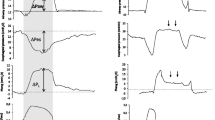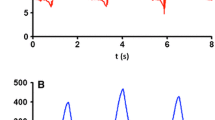Abstract
The objective of this 14-pig study was designed to determine the amount of lung ventilation obtainable by only rhythmic chest compression (100/min, 100 lbs). Tidal volume (TV), dead space (DS), and respiration rate (R) were measured with normal breathing and with rhythmic chest compression during ventricular fibrillation. The ratio of TV/DS was calculated in both cases. For normal breathing the ratio was 2.54 ± 0.68; for chest compression breathing the ratio was 0.80 ± 0.07. Minute alveolar ventilation (TV − DS)R was computed for both cases. With spontaneous breathing, the minute alveolar volume was 5.48 ± 2.1 l/min. With only chest-compression breathing, the alveolar ventilation was −1.49 ± 0.64 l/min. The negative minute alveolar volume and fractional ratio reveals that TV was less than the dead space indicating that chest-compression alone does not ventilate the lungs.


Similar content being viewed by others
References
Arnold JH, Thompson JE, Arnold LW. Single breath CO2 analysis: description and validation of a method. Crit Care Med. 1996;24:96–102.
Cobb LA, Eliastam M, Kerber RE, Melker R, Moss AJ, Newell L, et al. Report of the American heart association task force on the future of cardiopulmonary resuscitation. Circulation. 1992;85:2346–55.
Hallstrom A, Cobb L, Johnson E, Copass M. Cardiopulmonary resuscitation by chest compression alone or with mouth-to-mouth ventilation. N Engl J Med. 2000;342:1546–53.
Idris A, Becker LB, Furest RS, et al. Animal model of cardiac arrest. Circulation. 1994;90:306–9.
Acknowledgements
The authors wish to acknowledge the assistance of Amy Peterson, Melissa Bible, and Gena Brock, registered veterinary technicians who were responsible for anesthesia and instrumenting the animals. Funding was provided for this study by the Purdue University TRASK fund. This sponsor had no other involvement. The manuscript, as submitted or its essence in another version, is not under consideration for publication elsewhere, and will not be published elsewhere while under consideration by Resuscitation. Potential reviewers of this application would be Ray Fish, MD, PhD (rfish@uiuc.edu), John Boe, MD (jomboe@iupui.edu), and Robert Lew, MD, (robert.lew@barnardassociates.com) or (RaLew@aol.com). I ask that you do not include Karl Kern or Gordon Ewy as potential reviewers.
Author information
Authors and Affiliations
Corresponding author
Additional information
Supported by the Purdue Trask Fund.
Rights and permissions
About this article
Cite this article
Geddes, L.A., Rundell, A., Otlewski, M. et al. How Much Lung Ventilation is Obtained with Only Chest-compression CPR?. Cardiovasc Eng 8, 145–148 (2008). https://doi.org/10.1007/s10558-008-9058-8
Published:
Issue Date:
DOI: https://doi.org/10.1007/s10558-008-9058-8




